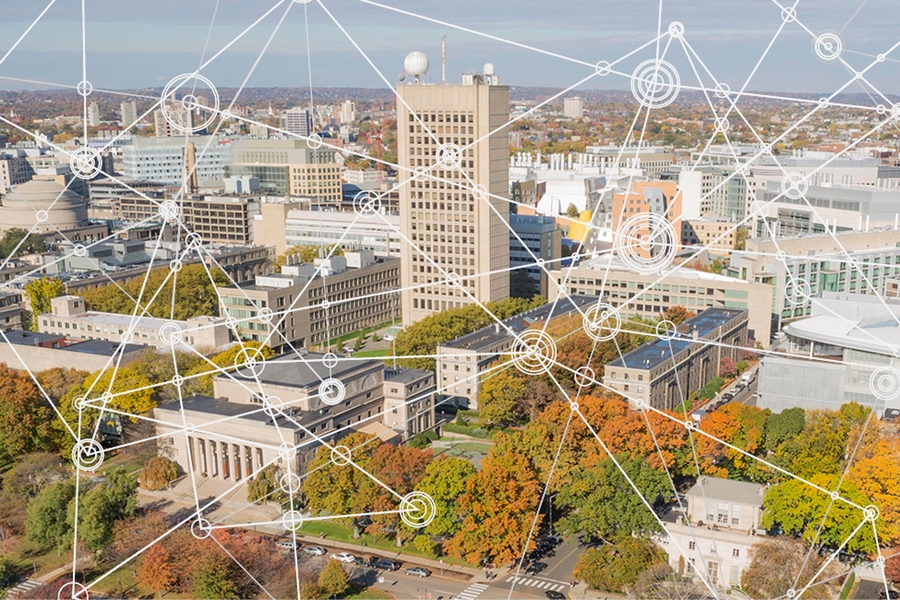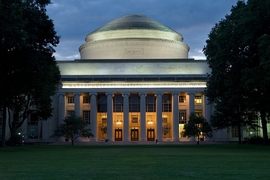School of Engineering faculty are embracing the new MIT Stephen A. Schwarzman College of Computing as a bold response to the rapid evolution of computing that is altering and, in many cases, fundamentally transforming their disciplines.
Inspired by student interest in computing, MIT President L. Rafael Reif launched an assessment process more than a year ago that involved widespread engagement with key stakeholders across the MIT community. Discussions were led by President Reif, Provost Martin A. Schmidt, and Dean of the School of Engineering Anantha P. Chandrakasan with Faculty Chair Susan Silbey playing a key role.
“The creation of the college is MIT’s first major academic structural change since 1950,” says Chandrakasan, the Vannevar Bush Professor of Electrical Engineering and Computer Science. “After consulting with faculty from across engineering and throughout MIT, the need to do something timely and deeply impactful was abundantly clear. Mr. Schwarzman’s inspired and amazingly generous support was instrumental to our ability to move forward.”
The school’s eight department heads and two institute directors recently spoke of the exciting possibilities ahead as the college, which represents a $1 billion commitment, gets underway. There will be a new building, a new dean, and 50 new faculty positions located within the college and jointly with other departments across MIT.
School leadership says the college meets a significant need partly because it directly aligns with recent activities and changes in some of their own practices. For example, many departments have adapted their hiring and recruitment practices to include a heavier emphasis on selecting faculty who can work at a high level in computation along with another specialized field, says Chandrakasan. “In some ways the change has arrived,” he says. “The college is our way of building a powerful framework and environment for research and collaborations that involve computing and that are occurring across disciplines. The college remains a young idea and its vibrancy and success will depend on thoughtful input from people across MIT, which I look forward to hearing.”
At the forefront
The eye of the storm of change has undoubtedly been in the Department of Electrical Engineering and Computer Science (EECS). Faculty do research to advance core computing topics while also addressing an inundation of requests to build bridges and connect their work with other disciplines. In the last two years alone, EECS faculty have established new joint academic programs with economics and urban science and planning.
The creation of the college will provide vital support and accelerate all kinds of computing-related research and learning that is happening across the Institute, says Asu Ozdaglar, School of Engineering Distinguished Professor of Engineering and EECS department head. “With the launch of the college, we hope that MIT’s leading position in research and the education of future leaders in computing will continue and grow.”
Markus Buehler, head of the Department of Civil and Environmental Engineering and the McAfee Professor of Engineering, agrees. “We have been at the forefront of this transformation of our discipline,” he says. The increased role of computing has impacted all five of CEE’s strategic focus areas, which include ecological systems, resources, structures and design, urban systems, and global systems. As a result, the department is now planning a potential new major between CEE and computer science, and the college will help in that effort, says Buehler. “The creation of the college will serve as a key enabler,” he says.
The MIT Institute for Data, Systems, and Society is also deeply aligned with the college, says Munther Dahleh, director of IDSS and the William A. Coolidge Professor of Electrical Engineering and Computer Science. IDSS works with all five schools to promote cross-cutting education and research to advance data science and information and decision systems in order to address societal challenges in a systematic and rigorous manner. IDSS plays a “bridge” role that will prove useful to the college, Dahleh says. It has launched cross-disciplinary academic programs, hired joint faculty in three schools, and enabled collaborations across all five schools.
“The new college will provide a structure for expanding these activities, he says. “And it will create new opportunities to connect with a larger community in sciences, social science, and urban planning and architecture.”
Steeped in computing
The timing is right for the college, say the faculty. “We are excited by the growth opportunities in computing because the nuclear science and engineering disciplines are so steeped in the development and application of numerical tools,” says Dennis Whyte, the Hitachi America Professor of Engineering and head of the Department of Nuclear Science and Engineering.
The Department of Aeronautics and Astronautics has a significant number of faculty working in information engineering for aerospace systems, particularly autonomous systems, says Daniel Hastings, the Cecil and Ida Green Education Professor at MIT and incoming head of the department.
“The college will allow us to expand our research and teaching into all the ways that computing technologies are changing the aerospace enterprise,” says Hastings. Those ways include deep learning to recognize patterns for maintenance in the operation of multiple aircraft, artificial intelligence for traffic control of fleets of uninhabited flying vehicles, and intelligent robotic systems in space to service low-Earth orbit satellites, among others.
Increasingly, the tools of machine learning and artificial intelligence are being fruitfully applied to materials design problems, says Christopher A. Schuh, the Danae and Vasilis Salapatas Professor of Metallurgy and head of the Department of Materials Science and Engineering (DMSE). “Our department sees computational thinking as a critical skill set for any budding materials scientist,” he says, adding a large fraction of DMSE faculty focus on computational materials science or use computational methods in designing new materials.
“We are excited to see MIT focusing on computing broadly, and we look forward to a deep materials-centric engagement with the college,” he says.
Growth opportunities
Paula Hammond, the David H. Koch Professor in Engineering and head of the Department of Chemical Engineering, would like to see the college provide new opportunities and pathways for chemical engineering to grow. One-third of faculty in her department work with computation as their primary research method, she says.
Hammond looks forward especially to the arrival of new faculty. “I see these new positions as a chance to hire faculty members who are rooted in the molecular and systems-oriented thinking that defines our field, while doing research in new and important areas, including global problems in environment, energy, health, and water.” She says such interdisciplinary faculty would be instrumental in building a new computational major in chemical engineering (10-ENG) that is currently in development.
Douglas Lauffenburger, the Ford Professor of Bioengineering and head of MIT’s Department of Biological Engineering, expresses a similar hope. “The creation of the college is a bold step, and I'm hopeful that some of these additional faculty positions will enable a strengthening of computational biology on campus.”
Training the next generation
Faculty also spoke of how the college will enable MIT students to play leadership roles in the future of computing — and other engineering fields. “It will strengthen our ability to train the next generation of mechanical engineers and better prepare students to join the workforce by exposing them to computation and AI throughout their education,” says Evelyn N. Wang, the Gail E. Kendall Professor and head of the Department of Mechanical Engineering.
An increasing number of research fields within mechanical engineering rely on computing technologies — from smarter autonomous machines to more accurate extreme event prediction and -3D printing. “The college will help students and researchers working in these fields advance their groundbreaking research even further,” adds Wang.
Elazer Edelman, the director of the Institute for Medical Engineering and Science, says the potential is vast. “From access to critical data sets to insights derived from machine and deep learning, the college will enable all of us to better interact as a community to address important problems and to train the next batch of young stars at the interface of science, engineering, computing and medicine,” he says. Edelman is the Edward J. Poitras Professor of Medical Engineering and Science at MIT.
“We at IMES are particularly excited to work with the college in interacting as a global community of scholars from this incredibly exciting and imaginative platform,” he says.







